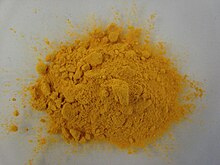
Back Gommagutta AF جمبوج Arabic Gutagamba Catalan Gummigutta German Gutagamba Spanish Gummigutt ET زرد گامبوجی FA Gomme-gutte French Getah manggis ID Gumiguto IO
| Gamboge | |
|---|---|
 | |
| Hex triplet | #E49B0F |
| sRGBB (r, g, b) | (228, 155, 15) |
| HSV (h, s, v) | (39°, 93%, 89%) |
| CIELChuv (L, C, h) | (69, 92, 48°) |
| Source | Maerz and Paul[a] |
| ISCC–NBS descriptor | Strong orange yellow |
| B: Normalized to [0–255] (byte) | |
Gamboge (/ɡæmˈboʊʒ, -ˈbuːʒ/ gam-BOHZH, -BOOZH)[1] is a deep-yellow pigment derived from a species of tree that primarily grows in Cambodia.[2] Popular in east Asian watercolor works, it has been used across a number of media dating back to the 8th century.[2]: 144 Easy to transport and manipulate into a durable watercolor paint, gamboge is notable for its versatility as a pigment in how it has been used in paintings, printing of books, and garment dyes,[3] including the robes of Buddhist monks.[4] Gamboge is toxic to humans, and is potentially deadly in larger doses.[citation needed] Due to its toxicity and poor lightfastness, gamboge is no longer used in paints, though limited use continues in other contexts. Though used in a number of different contexts, Gamboge is known not to react well with citric acid surfaces[clarification needed] therefore making it unsuitable for frescos and with white lead.[2]: 147 For its popularity, Gamboge has not been extensively identified in works of art from any time period; the few instances wherein art historians have attempted to identify whether or not the pigment was used in a given work have confirmed its widespread use and its longevity as staple within watercolor painting particularly in eastern art.[5]: 170
Cite error: There are <ref group=lower-alpha> tags or {{efn}} templates on this page, but the references will not show without a {{reflist|group=lower-alpha}} template or {{notelist}} template (see the help page).
- ^ Oxford English Dictionary, 2nd ed. (1989)[full citation needed]
- ^ a b c Winter, John (2007). "Gamboge". In Berrie, Barbara (ed.). A Handbook of Their History and Characteristics. Archetype. pp. 143–157.
- ^ Harley, R. D. (1970). Artists' pigments c. 1600-1835: a study in English documentary sources. London: Butterworths. ISBN 0-408-70004-1. OCLC 130595.
- ^ "Gamboge". The Craft Atlas. Retrieved 2023-08-02.
- ^ Nicholas Eastaugh (2004). The pigment compendium: a dictionary of historical pigments. Amsterdam: Elsevier Butterworth-Heinemann. ISBN 0-7506-5749-9. OCLC 56444720.